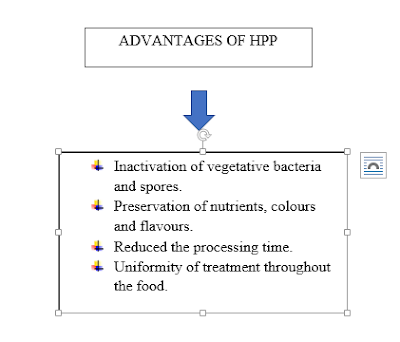Introduction to High Pressure Processing Process.
Food
processing is the transformation of raw animal or plant materials into products
that can be consumed to stabilize the food products by preventing or reducing
negative changes in quality. Without this food processing, the food cannot be
stored for a long time. Thus, this will be a problem for the food that need to
be transported for a long distance. Therefore, there are many food processing
technologies that can be explored and implemented in order to provide safety,
fresher-tasting and nutritive foods without using of heat or chemical
preservatives (E. Hogan, 2008) . One of the technologies
is by using high pressure processing (HPP).
High pressure processing (HPP)
is a non-thermal technique of food preservation that inactivates the harmful
pathogens and spoilage microorganisms by using pressure rather than heat to
induce a pasteurization effect. This pressure treatment can be used to both
liquid and solid foods with high moisture content (Giriprasad,
2015) .
Although it can kill the microorganisms, this pressure treatment does not break
the covalent bonds and has a minimal effect on food chemistry. Besides, the
treatment also can retain the food quality while avoiding the need for
excessive thermal processing or chemical preservatives. This treatment also
known as high hydro-static pressure (HHP) or ultra-high pressure (UHP)
processing (M.V. Muntean, 2016) .
Compared
to traditional thermal processing technology such as traditional thermal pasteurization,
HPP is performed at room temperature and thus reduces the energy consumption
that associated with heating and cooling process (M Sai
Srinivas, 2018) .
There are some advantages by using this high-pressure processing (HPP).
Figure 1: Denatured eggs by heat and pressure effect. (Source: M.V. Muntean, 2016)
Figure 1: Denatured eggs by heat and pressure effect. (Source: M.V. Muntean, 2016)
To
achieve the best pressure transmission, the ideal food for HPP has no gas
inclusions, no empty spaces in the package and a high content of moisture.
Vacuum packed products in flexible packages appear ideal for HPP, particularly
if the packaging could be compressed for about 15% with no structural damage
and if it were able to return to its original shape upon pressure release.
Currently, the flexible packs, jars, trays and bottles are used as HPP
packaging.
REFERENCES
E. Hogan, A. K. (2008). High
Pressure Processing of Foods:. An Overview.
Giriprasad, R. Y. (2015). HIGH
PRESSURE PROCESSING FOOD TECHNOLOGIES . International Journal of Science,
Environment and Technology, Vol. 4, No 1, 108 – 113.
M Sai Srinivas, B. M. (2018). High
Pressure Processing of Foods: A Review. The Andhra Agric. J 65,
467-476.
M.V. Muntean, O. M. (2016). High
pressure processing in food industry. Agriculture and agriculture science
procedia.





Comments
Post a Comment